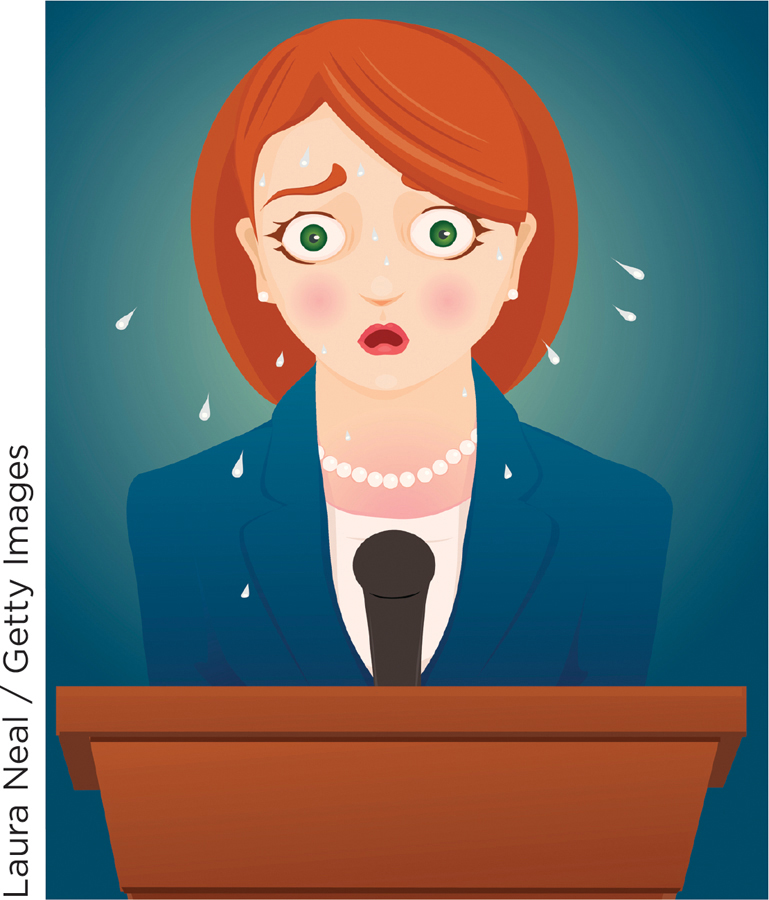15.5 Anxiety Disorders
How do you feel at the start of a job interview? Anxious. At the start f a big date? Anxious. When beginning a final exam? Anxious. Everyone sometimes experiences anxiety, an agitated emotional state that includes feelings of apprehension about impending danger or misfortune.
Although everyone experiences it, some people’s experiences of anxiety are extreme—
Anxiety is a unique emotion. It differs from fear (Sylvers, Lilienfeld, & LaPrairie, 2011). People are fearful when danger is staring them in the face: a mugger in an alley; a fast-
Just as there are different depressive disorders, there also are different types of disorders in which anxiety is a central symptom. We’ll look at five: Generalized Anxiety Disorder, Panic Disorder, Social Anxiety Disorder, Posttraumatic Stress Disorder, and Obsessive-
Generalized Anxiety Disorder
Preview Questions
Question
 What defines generalized anxiety disorder and how prevalent is it?
What defines generalized anxiety disorder and how prevalent is it?
 What therapies effectively treat generalized anxiety disorder?
What therapies effectively treat generalized anxiety disorder?
I’ve put up with this constant severe anxiety thrashing my body for 4 years now. I’m now 17 starting my senior year and I can’t function in school. My anxiety has been at a level which basically takes over my day, almost every day, and it has for the past 4 years. I wake up with the fight or flight response, walk downstairs with it, eat breakfast with it, struggle being around my family with it, and go to school barely managing to get through the classes. I have missed days of school and ditched classes a number of times because I got to the point I just couldn’t force myself to do it every day. I honestly don’t know how I even went through this for the past 4 years, completely out of control.
Am I alone? I don’t know. I feel even worse after I wrote this. Like the seriousness of it all hit me, and the question, “Am I one of the very few with this severe of anxiety?”
—(losthobbit, 2011)
The writer, a contributor to an online chat room, is not alone. She is one of millions of Americans suffering from generalized anxiety disorder (Newman et al., 2013).
689
DEFINING FEATURES AND PREVALENCE. Generalized anxiety disorder is a psychological disorder in which people experience high and persistent levels of tension, agitation, apprehension, and worry, even in the absence of a current event that provokes the feelings of anxiety (NIMH, 2009). DSM criteria for the disorder include the following (Andrews et al., 2010):
Worry about two or more aspects of life (e.g., relationships, health, finances, family affairs, or work).
The worry and anxiety occur on the majority of days.
The symptoms persist for at least three months.
In addition to the emotional reactions (anxiety) and thoughts (worry), people suffering from generalized anxiety disorder often display distinctive behaviors. They tend to avoid situations that provoke worry, to procrastinate when they need to take action or make decisions, and to spend excessive time preparing for activities. The disorder thus can disrupt many aspects of people’s lives.
Another common feature of generalized anxiety disorder is a perceived lack of control. People not only worry excessively, they also believe that stopping their worrying is beyond their capabilities (Andrews et al., 2010).
Generalized anxiety disorder affects nearly 7 million adults in the United States, which makes it the most prevalent of the anxiety disorders (Wittchen & Hoyer, 2001). It occurs about twice as often among women as among men.
TREATMENT. Both drugs and psychological therapies are used to treat generalized anxiety disorder (Portman, 2009). Drug therapies employ anti-
Drug therapies do not cure generalized anxiety disorders, however. They merely dampen the symptoms. To fully combat the disorder, then, therapists commonly combine drugs with psychological therapy strategies.
Two strategies you saw earlier in this chapter—
Despite these effects, psychotherapy for generalized anxiety disorder is less effective than one would hope. Therapy outcome studies do show that clients in psychotherapy improve, on average, compared with those in control groups. Nonetheless, many individual clients who receive therapy still do not improve substantially (Borkovec & Costello, 1993). Even the most effective cognitive therapies benefit only about half of the clients who receive them (Huppert & Sanderson, 2009).

690
WHAT DO YOU KNOW?…
Question 14
Which of the following statements are true of generalized anxiety disorder?
- FTfq5dKqggcPL9+r4E4PSf8ksTBd/3ule8rsU/s1nU+bUCWAuTCwQQvVgW3yQEPFgILXQ5NX3VvBvqy2DXk0E3w8rB2cOua2yG6xbTdHZZnsARINupmgJqdTeAOxqQG5NbB2YWWnp7cokE4oNQoxMRy1VxcRAJnamsdqUDTox66h1iB/4SHRgJyx+1j9lUmprYsxcgO1uuS1kXgswX6qA+KxJt7Nc3B0jIPRxMnPfunPOKZzkD7xWT8cm0U=
- JFfEVMoGePyZCutN8hWqeM1sNmcG1mq2/uM0ZUhez3JDIkFynAqcHvTlyGSfB52nR5HWK2zgLi1sxM2kpl9XkoNzpVY9g/LyXEjNq9DDDPP2fpk9WA0iwuRRs+WRpyfaABdmmZCxcyMgVGtOKBzPh6HyanoMSXPf5SRHBWB/KZSJnDG1CtnjYvZi5YGX8NdqF194zezD38s=
- xyAJq1zpf5qp8OERaH/8yF4EKOnrFrFwd47uutjFE8Sog34lmjkmR84tr09/AgK7VWFWYlbHRwMDTMCkwHoGD25HPhep2WTCl1nugwt6oP0gqaS5CqbWyYS4qbBpP2HrBmuOv2FzKQ78SqGEKEnmnwob9NLPcWEMPjG194oMMfg/Cvw2oLBKwP3XmkA6CZGYSSaiDmwPLbVjrWn6
- uMn2uCffM1hvlvgdCI/JQrPKH0aGcvoef2Edsu3DvGOYVKFAJC2SqWlu92aHCrs5yOsGylqrPds/xWsFULXR4EwIZR407J8mB3fVOg2X5chho8DawpntENLoAKcegzxQn6sCqT2pZqwBSbFR1q8GIDMoQHmKenkQ+fwGmWnF0k4KWf4a1iqn41fUdwv338on0gSPHGmvve5f5B+BtBsrXP9vkdAFuSg0w2h7YKxfMfh04txAeQrw286y5+VnbgiOGjrkWA==
Panic Disorder
Preview Questions
Question
 What defines panic disorder and how prevalent is it?
What defines panic disorder and how prevalent is it?
 What therapies effectively treat panic disorder?
What therapies effectively treat panic disorder?

In generalized anxiety disorder, worry and anxiety are persistently present. The next anxiety disorder we will consider is different: Panic disorder is a psychological disorder in which people experience sudden bouts of intense terror and extreme physiological arousal (NIMH, 2009).
DEFINING FEATURES AND PREVALENCE. The key defining feature of panic disorder is the occurrence of panic attacks. A panic attack is an episode of extreme fear, including high levels of physical arousal, that occurs suddenly and without apparent cause. During panic attacks, sufferers do not merely feel “worried”; they feel as if they are losing control of their body, having a heart attack, dying, or going insane. A 24-
The DSM specifies criteria for the disorder. They include the following:
The panic attacks are recurrent.
For one month or more, the person worries about the attack and its consequences.
The panic attacks are not side effects of a medication or other drug.
The prevalence of panic disorder is similar to that of generalized anxiety disorder. It affects about 6 million Americans and is twice as common among women as among men.
TREATMENT. A variety of psychotherapy strategies can benefit people suffering from panic disorder. One is psychoanalysis. In one study, participants diagnosed with panic disorder were assigned randomly to one of two types of therapy: (1) relaxation training, in which they were taught to relax various muscle groups, or (2) psychoanalytic therapy, in which therapists explored the personal meaning of participants’ panic symptoms. One patient, for example, was highly critical of herself during panic attacks, and psychoanalytic therapy indicated that negative experiences with her mother were at the root of the self-
Cognitive-
691
Yet another strategy for combating panic disorder is a behavioral approach discussed earlier, namely, exposure therapy. Therapists place clients into contact with the object or situation that triggers their panic, while ensuring that no harm will come to clients in the situation. Gradually, clients’ fear dissipates as they experience prolonged, harmless encounters with the situation that had triggered panic. A review of therapy outcome studies documents that exposure therapy effectively reduces panic symptoms (Sánchez-
What strategies do you use to lower arousal?
Finally, drug therapies are also an option for treating panic disorder. SSRIs, used to treat depression, as you learned earlier, have been shown to also be effective in reducing panic disorder symptoms (Batelaan, Van Balkom, & Stein, 2012). In practice, mental health professionals often combine drug therapies with a psychotherapy such as cognitive-
WHAT DO YOU KNOW?…
Question 15
Which of the following statements are true of panic disorder?
- YdGNRsLiJvmyNb4Tj92JXEtTyZgJl1uAMif0Sat8yg093oYuWwMHrI1UMRqqmZ20otYt5oAlWGfXEulkXZ/2UjcSSOosZahX00mahh3JgV2ApFl/0Z7OkGU/Bk0kkCcP9GNDV9babVf+5tWz1nSuALwwtEp0hptf8+oiKOrr9qajc6TwFEJFLGd2QIK8bNL5HgLB/qAxYuc=
- mpu+vJnsTVWzp0tydpEKD2UW3YMaqIbhvlFi718ThyApGYINF/k7Jv7nG7syAQCjgwEfFC1XyOvNmj3uX12p27sG9JwTygJ6sbHQJ4duBxP/U5FKzgNRGp+5WZos8r9tm3fw5l98WjQlD5vjxtkVKnRz3NGgZ9yjfGtQ0HeJtqXaTJFoeba81NudztdEGIqAmVzSzeMyZ3k=
- 6B4Z5/FgGrwRGy8VRKMznc//oT7ZhaBG+5e7mVURbEOkNuhF5yX4IKyBosv9Vc8cDUirNoAH6hSVNUk/MiqRbZME3n6c441PRoJaxCw5JiSqFZ3O09Xbn4Xb3bgiHBTy46b2+52HzH9L+PGySrTOAVCmo+YBvQWLwkG7b5mUjjgMXsPytjbZyaOIiZsKsCbhjQEL68VcGLZubYn+gpOmbNFDqlvWSD2P
- v76HPP2onbLnE1/4+1AvGUYx+5baHjq0/VXT2kV7x9QUReYEm/cat5h9T/7nmzXObiYByMyo6hFIOQgDbmMQ9YLvyM/iuFQ/g0oUQHUZYBlhN83JE8QUWcTQcPoddQktoQvLVWnoIpvaUux5qAjbVRn2y4es2TmyPnxg1MYIRJBR97pYrJj6ulAENlb/XEgA6N1SftZGaNkAfDkcX52MvZCl1mvwtZtqlIofUncwd3SlbfSArcHkdJJhChkSVy2PzrUTmv+vzF6JR+XkN1xQH2Wm1ipkKuz7tsqrW7li/aKq3QzRTrv4d5SKLW3H9Pa5SYb+fFn0Fu/u3hTuaKiqO0XllJ5d//ZaWXkK6HSZAeTWnSdC/yTDBgNoE4wDFXVJHk5Eftrsuac=
Social Anxiety Disorder
Preview Questions
Question
 What defines social anxiety disorder and how prevalent is it?
What defines social anxiety disorder and how prevalent is it?
 What therapies effectively treat social anxiety disorder?
What therapies effectively treat social anxiety disorder?

In the two anxiety disorders we just reviewed, generalized anxiety disorder and panic disorder, anxiety and worry can occur in virtually any type of situation. The next disorder is different. Social anxiety disorder is defined by extreme levels of anxiety and self-
People who suffer from social anxiety disorder are intensely worried about embarrassing themselves in front of others who, they believe, are observing and evaluating them (NIMH, 2009). Everyone sometimes has worries about social embarrassment. But in social anxiety disorder, people experience “overwhelming terror” in response to even the “simple process of interacting with people” (Turk, Heimberg, & Magee, 2008, p. 123). These reactions can substantially lower socially anxious people’s overall quality of life, with fear of embarrassment interfering with the ability to take part in routine activities. For example, a mother with social anxiety disorder reports that “I feel anxious when I attend parents’ meetings in my children’s classes. … I am afraid that I will blush. … [I] go completely blank and cannot think of anything to say” (Jensen, Hougaard, & Fishman, 2013, p. 288).
692
DEFINING FEATURES AND PREVALENCE. According to DSM criteria, individuals have social anxiety disorder only if their anxiety is persistent and extreme. Criteria include the following:
Persistent fear of social situations and anticipation of humiliation and embarrassment in such situations.
A recognition by the individual that the anxiety is excessive.
The anxiety interferes with the person’s normal professional or social activities.
These symptoms last at least six months.
Social anxiety disorder is very prevalent. Surveys indicate that 12.1% of U.S. citizens experience social anxiety disorder at some point in their adult lives (Turk et al., 2008). This percentage is so high that, to some, it raises a possibility discussed earlier in this chapter, namely, that the disorder is overdiagnosed. Some express concern that normal, everyday shyness may inappropriately be diagnosed as a psychological disorder (Swinson, 2005). Despite this concern, however, millions of individuals unquestionably do experience extreme levels of social anxiety that erode the quality of their life. Let’s consider therapies available for them.
TREATMENT. A variety of therapy strategies have been used to combat social anxiety disorder, and the good news is that many are effective. Meta-
Different therapy strategies can each be effective in treating social anxiety disorder. As with other anxiety disorders, anti-
One advantage of group therapy involves social skills. People with social anxiety disorder may lack some skills; for instance, they might not be good at starting a conversation or establishing eye contact with others. Furthermore, even when their skills are adequate, they may underestimate themselves and judge that they are socially inept (Heimberg, 2002). Group therapy gives clients an opportunity to learn new social skills that they can test out in the group. In one study, clients received instruction on topics to discuss in social conversation, appropriate ways of speaking in those conversations (e.g., maintaining sufficient voice volume), and nonverbal behavior to perform when conversing (e.g., establishing eye contact, displaying appropriate facial expressions). They also received “homework assignments” to practice those skills. Compared with others, clients receiving social skills training in a group setting showed a substantial reduction in social anxiety disorder symptoms (Herbert et al., 2005).

693
WHAT DO YOU KNOW?…
Question 16
Which of the following statements are true of social anxiety disorder?
- mEIBFIWuAjGoi9aXgzj2TAyhV4tvh4fVKyqaZ55A9IORmY1vJSyxlI1HY1zleVPH/0xX7hVhrp7L2ZHtlaLYKXQukPZWYfFa8FwPGOFMxsa/cGejI+8bt9lANiphFEQGuh9orTCDgon89FYM0Qn+oG2zJPg4ZohZ2qoavd4JxblHtv0QgJf8fKXZozMI7gVFNdCvR1wkle3HGjdOklDtv3ZoXg9WXWZIZQ+QaECtA9/fVjBkcLm8I5mm21mtFfh/+VQ21FXAB9ym2cE9LRXThS6a30U=
- 9c2h5Iu/0v1jJnevV78aSWyyQeUpGOL+UQ9AHqZIqNNcFelgmFjHOWwbyH4+8niP22L17jrua9yJmRmWAqROfk32jVQ6TxJhJgKH9rYIZ3mhpg+7Ik6xT8sF3A7mabBiG+nLNrhIFGy8TjPcNhr8AgBrvBZACDNgs6zO8f5hOsD3YN99l8JeGQ==
- fQlHKHgvF9nM1HMYRr3IFM2iRrfCkrQtp2USqbWB5v4jAfDHw0hRBgiogiyox29U8uzn00G3ea2r25LtK1tMvrHyTVCivA5WaSxQB9M8MZZ/1hZ+0F+hA00haaKnxWp7H4cI+lhjsPk9KYc4lpxNQpQHnavA1bwGyGHqgTNIlyPV8oDeSGFpD0VYRGK9NPQ1330DLA==
- pOo1BQIDKkAhqdd/hD5yKa2gUL8noV7cBbQWHUGDXrx9KRorKIx1W1kl4BOvHs/QUfE5O/AHzEV28HX77CHX4anKqm/ib6PCGLj5Z3m+BJowkkM/3RbKYt0lQNFOgHC+9xA156NIq5dX8IQj9akltcxf+xLV5u6RY0A9UWUJH/qC4Ut7L4b+6GsbdajDgZFy9iMTWMrJ7xAAR85wnxTRalawbRRTzKD1WDUIfgTt63/f6JanrEiswtW7kGyJIZm0ifY6g9uSegQp58T7s/aI2fzuVLv+Zu28DyK2Bb+2v7l8k9Pjl8oECqGMTyWtL/O5KFqUqahzJfbD1JWqYUx511EsMShRjymDqdXf+TsU+vU=
Phobias
Preview Questions
Question
 What defines phobias and how prevalent are they?
What defines phobias and how prevalent are they?
 What therapies effectively treat phobias?
What therapies effectively treat phobias?
In a panic attack, as you learned, people experience extreme fear but do not know why. In another type of disorder, people know why; they can readily tell you what causes them to become afraid. Their excessive fear reactions are called phobias.
DEFINING FEATURES AND PREVALENCE. Phobias are strong, persistent fears caused by situations that pose little or no actual threat. There are different types of phobic disorder. Specific phobias are fears directed toward particular objects or situations (LeBeau et al., 2010). People who are afraid of flying, heights, snakes, spiders, or closed-
Agoraphobia is a fear of being in diverse social situations outside one’s home. Someone with agoraphobia might avoid stores, theatres, public transportation, or any setting in which crowds are present (Wittchen et al., 2010). (The word agora is Greek for “gathering place” and refers to the location in a town where people meet socially; “agoraphobia” thus is a fear of people in such social gathering places.)
Specific phobias are common. Nearly 20 million adult Americans (8 to 9% of adults) experience some form of specific phobia (NIMH, 2009). Agoraphobia is much rarer, afflicting about one-
TREATMENT. When it comes to treating phobias, it is worth remembering the old adage “You have to get back on the horse that threw you.” A particularly effective way for people to overcome phobias is by directly confronting their fears, rather than merely talking about them.
A key strategy for confronting fears is thus exposure therapy. Exposure therapy treats phobias effectively (Choy, Fyer, & Lipsitz, 2007), especially when it increases clients’ beliefs in their personal ability to cope with the feared stimulus (Bandura, 1986).
A closely related strategy is mastery therapy (Williams & Zane, 1997). In mastery therapy, therapists accompany clients to situations that they fear and perform activities with them. Therapists treating agoraphobia, for example, might join clients shopping at a mall or riding on a bus (Gloster et al., 2011). Therapists gradually reduce the amount of help they give to clients, so clients can learn to master their fears on their own. In therapy, these behavioral experiences are commonly combined with cognitive strategies designed to boost clients’ confidence in their ability to overcome their fears.
694

The cognitive-
Research finds that therapies change phobic behavior by affecting not only the mind (e.g., people’s beliefs about feared stimuli and their ability to cope with them), but also the brain (Paquette et al., 2003). People with spider phobias participated in a cognitive-
We’ll conclude this chapter with two disorders that involve anxiety, yet have enough distinctive features that DSM-